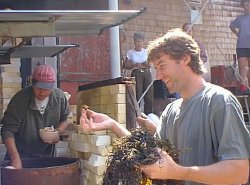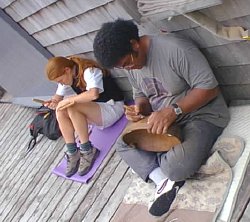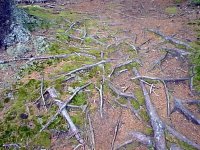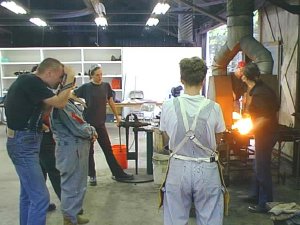
Haystack deck on which restless crowds gather in sunshine and thunderstorms.

Haystack director Stu Kestenbaum advising newcomers on the essential role of poetry in daily life.

Shiro Otani conducting Yoko and Charlotte through a crit in the clay studio

Jamie throws a crab into the raku kiln for that unique finish.

Dutch artist Peter Gentenaar turns pulp ficiton into reality in his paper workshop.

Chunghie Lee oversees her crew of fibre artists as they patch together in the traditonal Korean manner.
 Pierre Cavalan hunts through the
plethora of flea markets along the Maine coast for that sublime object of trash.
Pierre Cavalan hunts through the
plethora of flea markets along the Maine coast for that sublime object of trash.
Pierre's metal studio enjoy the fruits of their labour on the last night of the session.
 Fijian
wood artist Makita Koto sits with Julia as they carve the perfect notch.
Fijian
wood artist Makita Koto sits with Julia as they carve the perfect notch. Roots from
the abundant spuce trees on Deer Isle lay waiting for the absent-minded walker.
Roots from
the abundant spuce trees on Deer Isle lay waiting for the absent-minded walker.
Anne Catrin Evans instructs her blacksmithing class in the Welsh art of steel forging.
 Hye
Jang Park airs her work from the fibre studio.
Hye
Jang Park airs her work from the fibre studio.
Residents of the International Session have to make do with a simple lobster dinner in poor lighting conditions.
 A horizon is an
essential ingredient in any craftsmanship.
A horizon is an
essential ingredient in any craftsmanship. Pierre Cavalan's contribution to
the Haystack crown jewels.
Pierre Cavalan's contribution to
the Haystack crown jewels.
Australian writer-in-residence Kevin Murray tests out the weight of the American myth.
Haystack Mountain School of Crafts offers a season of summer workshops for professionals and dedicated amateurs. Each fortnight, around 85 people gather on Deer Isle off the coast of Maine to work, live and play together (in that order). The 1998 international session included workshops by a Japanese ceramist, a Dutch papermaker, a Fijian wood-carver, an Australian jeweller and a Welsh blacksmith. While individuals spent their days in their assigned studios, the session came together for slide presentations, poetry readings, Japanese tea ceremony, Beckett play and a very sober auction.
The area around Haystack has half a dozen high quality craft galleries, representing work of locals, visitors and school's faculty. The predominant industry, however, is lobster fishing. The first America's Cup crew came from Deer Isle. Road-signs demonstrate the bone dry local humour: a local restaurant advertises 'Lousy food & warm beer'. Haystack seems to have acquired that air of laidback resilience.
Haystack participants come from three walks of life. Such is the regard for Haystack, that the professional students include previous instructors. They are joined by people who've moved into Maine just to be near Haystack, and stressed high-achievers wanting manual relaxation. Despite different degrees of experience, there is little evidence of hierarchy during the fortnight. One possible reason for this is the American ritual of summer camp, where children learn to pitch in together for several weeks each year.
The work ethic was intense, but exhilarating. Half way through the session, we had a special picnic, where we sat on warmed granite boulders, eating local lobster, watching the sun set over the bay. Rather than continue carousing until sunrise next day, the conversations idled back to the workshops, where the day's work gleefully re-commenced. The usual social prohibition on work was gleefully abandoned.
As writer-in-residence, it was my task to conduct writing workshops and produce a long essay for their annual monograph. While there, I mined conversations with those whose work exists outside craft. There's much to be learned about the contemporary relevance of manual arts from those who come to it for relief from an increasingly abstract work experience. One particularly rich vein of understanding came from an excellent wood-design student whose day job was to render fur on digital animations such as Babe. The solitude of wood provided necessary relief from the hive-like work inside computer systems.
On the night after leaving Haystack, Pierre Cavalan and I went to see Truman Show in a Bangor. Like the hero of that film, we couldn't help but wonder if this idyllic fortnight had all been carefully stage-managed, down to the weather. Perhaps our idiomatic scepticism is one reason why we have no live-in craft camp in Australia. Otherwise, we couldn't recommend it highly enough.